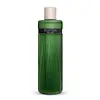Onsensou Scalp Care Shampoo With Hot Springs Algae Essence Versus AG Care Balance Apple Cider Vinegar Sulfate-Free Shampoo
What's inside
What's inside
 Key Ingredients
Key Ingredients

No key ingredients
 Benefits
Benefits

No benefits
 Concerns
Concerns

 Ingredients Side-by-side
Ingredients Side-by-side

Water
Skin ConditioningSodium Lauroyl Sarcosinate
CleansingPotassium Cocoyl Glycinate
Sodium Lauroyl Methyl Isethionate
CleansingHydroxypropyl Methylcellulose
Emulsion StabilisingPolysorbate 20
EmulsifyingPotassium Chloride
Phenethyl Alcohol
MaskingSodium PCA
HumectantPisum Sativum Peptide
Skin ConditioningCaprylyl Glycol
EmollientDecyl Glucoside
CleansingParfum
MaskingGuar Hydroxypropyltrimonium Chloride
Skin ConditioningPropanediol
SolventTrisodium Ethylenediamine Disuccinate
Citric Acid
BufferingPhenoxyethanol
PreservativeGlycerin
HumectantButylene Glycol
HumectantCitral
PerfumingPanthenol
Skin ConditioningAcetum
Linalool
PerfumingAloe Barbadensis Leaf Juice Powder
Skin ConditioningHelianthus Annuus Seed Extract
Skin ConditioningAcacia Concinna Fruit Extract
Skin ConditioningBalanites Aegyptiaca Fruit Extract
Argania Spinosa Kernel Oil
EmollientLeuconostoc/Radish Root Ferment Filtrate
AntimicrobialTetrasodium Glutamate Diacetate
Polysorbate 80
EmulsifyingGypsophila Paniculata Root Extract
Skin ConditioningPrunus Armeniaca Fruit Extract
Skin ConditioningPrunus Persica Fruit Extract
AbrasivePyrus Malus Fruit Extract
Skin ConditioningSodium Benzoate
MaskingBenzyl Alcohol
PerfumingPotassium Sorbate
PreservativePrunus Amygdalus Dulcis Seed Extract
Skin ConditioningPanicum Miliaceum Seed Extract
Skin ConditioningLinum Usitatissimum Seed Extract
PerfumingOlea Europaea Leaf Extract
PerfumingRosmarinus Officinalis Leaf Extract
AntimicrobialArnica Montana Flower Extract
MaskingSorbic Acid
PreservativeAcetic Acid
BufferingWater, Sodium Lauroyl Sarcosinate, Potassium Cocoyl Glycinate, Sodium Lauroyl Methyl Isethionate, Hydroxypropyl Methylcellulose, Polysorbate 20, Potassium Chloride, Phenethyl Alcohol, Sodium PCA, Pisum Sativum Peptide, Caprylyl Glycol, Decyl Glucoside, Parfum, Guar Hydroxypropyltrimonium Chloride, Propanediol, Trisodium Ethylenediamine Disuccinate, Citric Acid, Phenoxyethanol, Glycerin, Butylene Glycol, Citral, Panthenol, Acetum, Linalool, Aloe Barbadensis Leaf Juice Powder, Helianthus Annuus Seed Extract, Acacia Concinna Fruit Extract, Balanites Aegyptiaca Fruit Extract, Argania Spinosa Kernel Oil, Leuconostoc/Radish Root Ferment Filtrate, Tetrasodium Glutamate Diacetate, Polysorbate 80, Gypsophila Paniculata Root Extract, Prunus Armeniaca Fruit Extract, Prunus Persica Fruit Extract, Pyrus Malus Fruit Extract, Sodium Benzoate, Benzyl Alcohol, Potassium Sorbate, Prunus Amygdalus Dulcis Seed Extract, Panicum Miliaceum Seed Extract, Linum Usitatissimum Seed Extract, Olea Europaea Leaf Extract, Rosmarinus Officinalis Leaf Extract, Arnica Montana Flower Extract, Sorbic Acid, Acetic Acid
Ingredients Explained
These ingredients are found in both products.
Ingredients higher up in an ingredient list are typically present in a larger amount.
Citric Acid is an alpha hydroxy acid (AHA) naturally found in citrus fruits like oranges, lemons, and limes.
Like other AHAs, citric acid can exfoliate skin by breaking down the bonds that hold dead skin cells together. This helps reveal smoother and brighter skin underneath.
However, this exfoliating effect only happens at high concentrations (20%) which can be hard to find in cosmetic products.
Due to this, citric acid is usually included in small amounts as a pH adjuster. This helps keep products slightly more acidic and compatible with skin's natural pH.
In skincare formulas, citric acid can:
While it can provide some skin benefits, research shows lactic acid and glycolic acid are generally more effective and less irritating exfoliants.
Most citric acid used in skincare today is made by fermenting sugars (usually from molasses). This synthetic version is identical to the natural citrus form but easier to stabilize and use in formulations.
Read more about some other popular AHA's here:
Learn more about Citric AcidParfum is a catch-all term for an ingredient or more that is used to give a scent to products.
Also called "fragrance", this ingredient can be a blend of hundreds of chemicals or plant oils. This means every product with "fragrance" or "parfum" in the ingredients list is a different mixture.
For instance, Habanolide is a proprietary trade name for a specific aroma chemical. When used as a fragrance ingredient in cosmetics, most aroma chemicals fall under the broad labeling category of “FRAGRANCE” or “PARFUM” according to EU and US regulations.
The term 'parfum' or 'fragrance' is not regulated in many countries. In many cases, it is up to the brand to define this term.
For instance, many brands choose to label themselves as "fragrance-free" because they are not using synthetic fragrances. However, their products may still contain ingredients such as essential oils that are considered a fragrance by INCI standards.
One example is Calendula flower extract. Calendula is an essential oil that still imparts a scent or 'fragrance'.
Depending on the blend, the ingredients in the mixture can cause allergies and sensitivities on the skin. Some ingredients that are known EU allergens include linalool and citronellol.
Parfum can also be used to mask or cover an unpleasant scent.
The bottom line is: not all fragrances/parfum/ingredients are created equally. If you are worried about fragrances, we recommend taking a closer look at an ingredient. And of course, we always recommend speaking with a professional.
Learn more about ParfumPhenoxyethanol is a preservative that has germicide, antimicrobial, and aromatic properties. Studies show that phenoxyethanol can prevent microbial growth. By itself, it has a scent that is similar to that of a rose.
It's often used in formulations along with Caprylyl Glycol to preserve the shelf life of products.
Polysorbate 80 is a surfactant and emulsifier. It is used to keep ingredients together, and prevent oils and waters from separating.
It is made from polyethoxylated sorbitan and oleic acid. This ingredient can be found in cosmetics, foods, and medicine. It is water-soluble.
Polysorbate 80 may not be fungal acne safe.
Learn more about Polysorbate 80Water. It's the most common cosmetic ingredient of all. You'll usually see it at the top of ingredient lists, meaning that it makes up the largest part of the product.
So why is it so popular? Water most often acts as a solvent - this means that it helps dissolve other ingredients into the formulation.
You'll also recognize water as that liquid we all need to stay alive. If you see this, drink a glass of water. Stay hydrated!
Learn more about Water